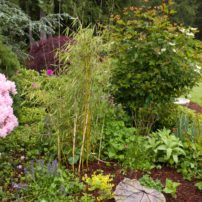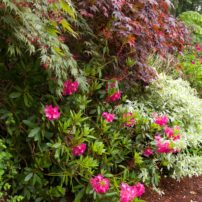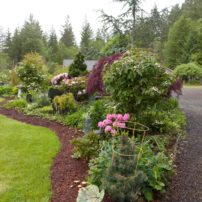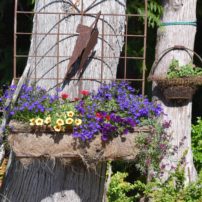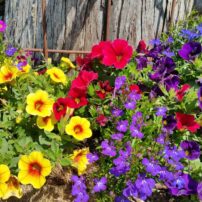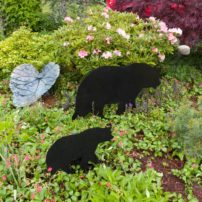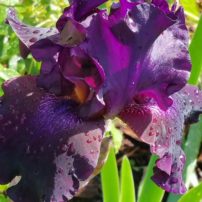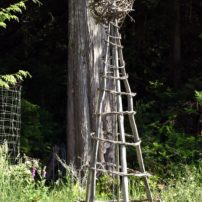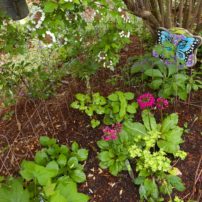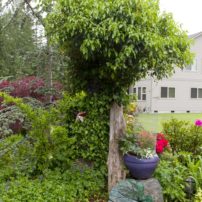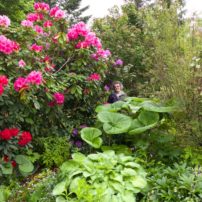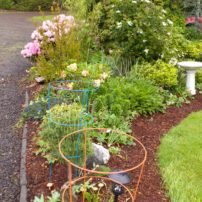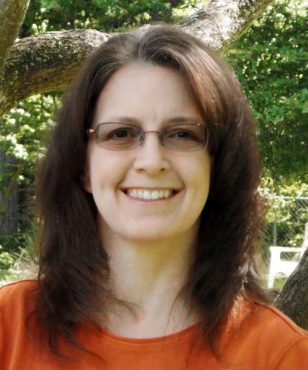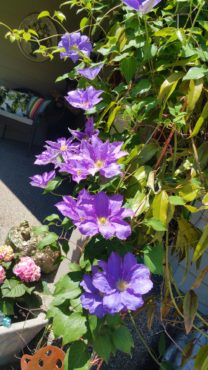 A passion for gardening is often passed down from generation to generation, and for Dorene Fretwell, that is certainly true. Fretwell has been a certified Master Gardener since 2007 and has used her horticulture knowledge, creativity and intuition to create a beautiful woodland garden at her home in Seabeck.
A passion for gardening is often passed down from generation to generation, and for Dorene Fretwell, that is certainly true. Fretwell has been a certified Master Gardener since 2007 and has used her horticulture knowledge, creativity and intuition to create a beautiful woodland garden at her home in Seabeck.
“My love of gardening started with my mother, Coral,” she says.
After Fretwell’s father died, her mother raised Fretwell and her four siblings by herself.
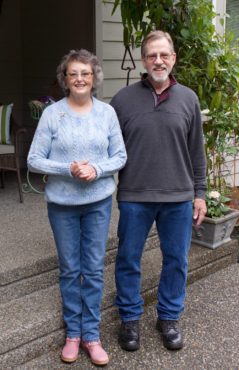
“We had very little growing up, but we did have flowers,” Fretwell recalls. “My mother was a wonderful gardener. She especially loved her roses later in life. We had a beautiful hydrangea by the porch, sweet Williams, daisies, irises and other flowering plants. Grandmother Pearl Fretwell was also an incredible flower gardener, and my grandma Iva Parr always had remarkable begonias.”
The Garden’s Beginnings
Fretwell and her husband, Marc, purchased their large, forested parcel nearly 20 years ago after finding it while hiking. Their house sits at the edge of a canyon on their property, where an abandoned railroad trestle from the historic Seabeck Railroad remains.
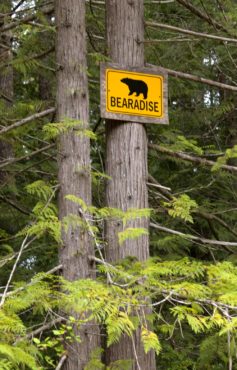 “It was the main railroad between Seabeck and Camp Union in the 1850s,” Marc Fretwell says. “We could sit here and look right into the bottom of the canyon, and see the railroad grade in the wintertime because all the leaves were gone.”
“It was the main railroad between Seabeck and Camp Union in the 1850s,” Marc Fretwell says. “We could sit here and look right into the bottom of the canyon, and see the railroad grade in the wintertime because all the leaves were gone.”
The forest has since reclaimed the canyon, giving the couple a beautiful woodland setting for their home.
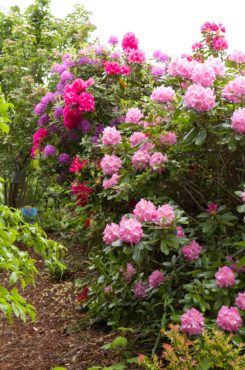 A local historian they know says one of the large evergreens they can see across the canyon might also be historic, and hopes to measure it someday.
A local historian they know says one of the large evergreens they can see across the canyon might also be historic, and hopes to measure it someday.
The Fretwells worked the property for a few years before they built their house on it in 2004, having the land contoured and bringing in boulders to add to the landscape.
“My gardens would not be what they are without Marc’s original work and artistic eye,” Fretwell says.
They planted rhododendrons and Japanese maples, and Fretwell put in a garden, watering the plants with water drums that her husband filled and hauled on the back of his truck.
At the time, Fretwell was driving both of her boys to and from their schools and working on the new property while still living at their other home.
“It was kind of crazy,” she says.
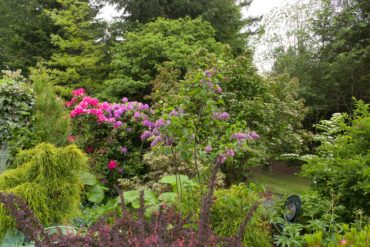 Working with the Natural
Working with the Natural
Fretwell’s garden is a place where she can create, experiment, design and relax.
“As a kid, I always had a love of art, and dirt and ground to me are like a blank canvas,” she says. “You get to paint your own picture, and then you get to study it to see what it will look like in different seasons. It’s also a huge stress relief.”
Fretwell has created 5 acres of individual gardens, each with its own distinct character. Some share the grass lawn surrounding the house, one is an edible garden, and others border the forest.
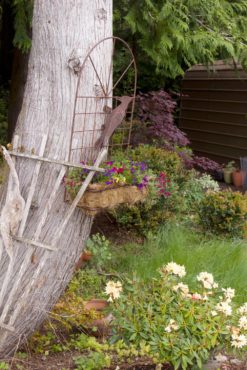 As a frugal gardener, Fretwell propagates when she can, starting seeds in her greenhouse and trading plants, seeds and bulbs with friends. This year, she had success starting some of her seeds through winter sowing, using milk jugs to form miniature greenhouses for the seeds and soil.
As a frugal gardener, Fretwell propagates when she can, starting seeds in her greenhouse and trading plants, seeds and bulbs with friends. This year, she had success starting some of her seeds through winter sowing, using milk jugs to form miniature greenhouses for the seeds and soil.
“I am constantly dividing plants and moving them around,” she says.
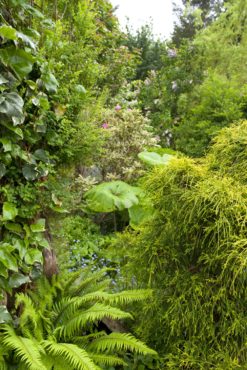 Her trick is to “let it get going, let it get established, then divide and relocate it to another bed.”
Her trick is to “let it get going, let it get established, then divide and relocate it to another bed.”
“If something doesn’t do well when it’s young, I move it. I’m pretty thrifty,” Fretwell says.
Fretwell designed the woodland gardens with layers, placing small, shade-loving plants in front of larger ones. She gave her woodland gardens a natural aesthetic, complementing them with footpaths that seem to disappear as they curve around plants, accented with large-leaf plants that can grow to 5 feet tall.
She adores large-leaf plants.
“I love the different shapes and textures, and different shades of green,” she says.
One of her favorite woodland gardens has trilliums, primulas, bleeding heart, astrantias, clematis, ferns, hostas, podophyllum ‘Spotty Dotty,’ legularis and ground covers growing in front of rhododendrons, maples and mayapples.
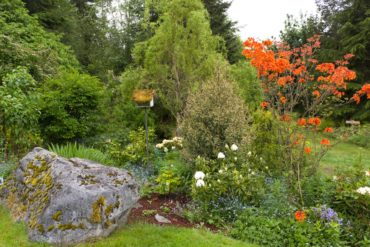 Fretwell is skilled at mixing colors and likes to add white plants such as Casa Blanca lilies, trilliums and white rhododendrons to help blend the colors.
Fretwell is skilled at mixing colors and likes to add white plants such as Casa Blanca lilies, trilliums and white rhododendrons to help blend the colors.
“I don’t sit back and think, ‘What color scheme should be here?'” she says.
Some of Fretwell’s favorites are what she calls “commons,” such as Rudbeckia (black-eyed Susan) and hardy geraniums. She even planted periwinkle between her front steps for a pop of purple in spring.
“It has nowhere to go and has not gotten out of control in all these years,” Fretwell says.
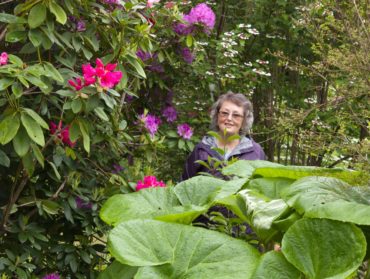 In her garden, evergreens fill the gap when the deciduous trees have lost their leaves and herbaceous perennials have completed their cycle. Fretwell’s evergreen collection includes fir, cedar, spruce, boxwood and pine.
In her garden, evergreens fill the gap when the deciduous trees have lost their leaves and herbaceous perennials have completed their cycle. Fretwell’s evergreen collection includes fir, cedar, spruce, boxwood and pine.
Behind a rustic gate and tall, wooden fence is Fretwell’s edible garden. She grows berries along with squash, peppers, lettuce, onions, tomatoes, rhubarb, potatoes and lots of other vegetables in raised beds her husband made.
David Austin roses, dahlias, poppies, lilies and other flowers grow in the space between the raised beds, and annuals spill from wheelbarrows. Fretwell likes it better now than when she contained everything within the raised beds.
“It kind of looked like a cemetery before. It needed a little character,” she says, laughing.
 Keeping Birds in Mind
Keeping Birds in Mind
Fretwell considers birds when choosing plants for her garden.
“I look after them in what I grow and leave in the gardens, and I feed them with flowers, seed heads and berries,” she explains.
She planted winterberry, crabapple, elderberry and viburnums for their colorful berries that birds and other wildlife can eat.
“I cannot forget my boyfriend, Jacob Cline bee balm. He is a tall perennial with dark red flowers that look like an exotic bird. The hummers love that plant,” she says.
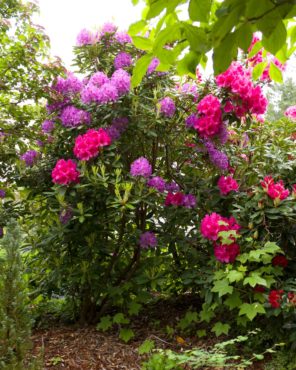 Stewards of the Land
Stewards of the Land
“We try to be good land stewards,” Fretwell says.
Keeping her gardens as natural as possible, she works with what she has. Pointing out flowers that came up in one garden bed on their own, she adds, “We always work with natives. I’m not the kind of gardener who brings in truckloads of dirt and builds a garden that way. I amend what’s there. We also have two big compost drums, and (the compost) always goes into the gardens.”
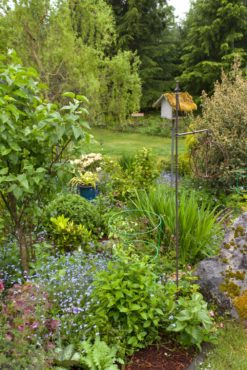 For weed control, Fretwell uses organic methods, including pulling weeds by hand, thinning and limbing up to provide good air circulation.
For weed control, Fretwell uses organic methods, including pulling weeds by hand, thinning and limbing up to provide good air circulation.
“This really helps with horsetail, along with a little soil sweetener,” she says.
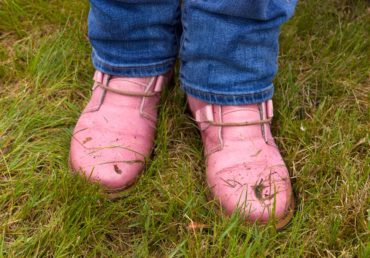 Her garden is well-kept, and she takes pride in her pruning skills.
Her garden is well-kept, and she takes pride in her pruning skills.
“I absolutely love to prune. I don’t want my maples to look like ‘Cousin Itt,'” she says, referring to a character from the classic TV show and the movie “The Addams Family.”
While Dorene Fretwell is the gardener, Marc Fretwell maintains their private road and surrounding woods, mows the lawn, drops dead trees, pulls out diseased and dead shrubs, and cuts firewood for winter heat. When he cuts down a tree, he rounds the edges of the remaining stump with his chainsaw.
“It makes it look more interesting and things don’t snag on the stumps,” he says.
 Art and Creativity in the Garden
Art and Creativity in the Garden
Incorporating artistic elements is one of Fretwell’s favorite things about gardening. She tucks boulders, driftwood, garden art, arbors, pots and other things here and there to add visual interest, and loves little surprises in the garden.
When asked where she gets her garden art, she replies, “When we want something, we usually make it ourselves.”
Fretwell enhanced her gardens with concrete castings she made from rhubarb, gunnera pumpkin and hosta leaves with her husband’s assistance; a large obelisk she made from cedar fence rails and cedar branches with a friend; and other things she makes herself when she wants to.
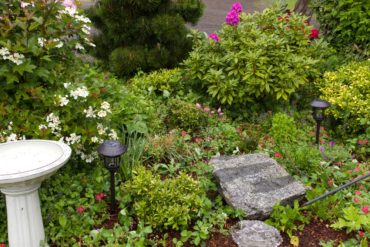 “I (also) love shopping garage sales,” Fretwell says, pointing out things hanging from branches, affixed to tree trunks and posts, and peeking out from plants.
“I (also) love shopping garage sales,” Fretwell says, pointing out things hanging from branches, affixed to tree trunks and posts, and peeking out from plants.
When Fretwell isn’t gardening, she can often be found sharing her horticulture knowledge and using her artistic talent in other ways. Along with being an active Master Gardener, she is a member of PNW Plant Geeks, a Facebook group where experienced garden enthusiasts and horticulture professionals share knowledge and ideas about ornamental plants, native plants, garden and landscape design, ecorestoration and floristry.
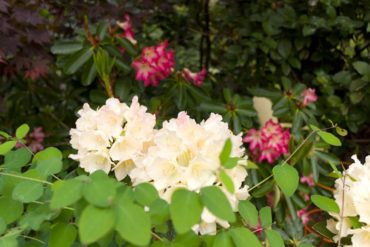 Fretwell also makes flower arrangements for her church; has taught classes on floral design; and has made quilts, including a beautiful rose quilt for her mother, a quilt with bears on them for each of her sons, a lap quilt for her husband and several for her home.
Fretwell also makes flower arrangements for her church; has taught classes on floral design; and has made quilts, including a beautiful rose quilt for her mother, a quilt with bears on them for each of her sons, a lap quilt for her husband and several for her home.
“I use my own designs and love working with colors,” she says.
Sharing the Land with Wildlife
The couple have seen an abundance at their property, including bears, deer, coyotes, barred owls, eagles, redtail hawks, ospreys, rabbits, bullfrogs, squirrels, chipmunks and more.
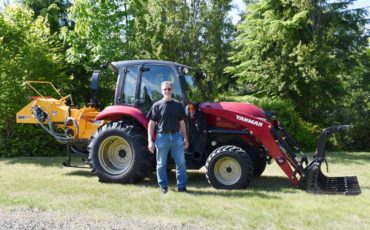
“In winter, when the crabapples are dried, the bard owls will line up in the grass to catch the mice and voles. We can look right outside our sliding glass door and watch them,” Fretwell says.
Wildlife are also drawn to a boulder that sits on their back lawn, having a scooped shape in it that holds water.
“One morning, my husband woke me up about 3 a.m. (to show me) there was a Virginia rail in the water,” she says.
Another wildlife encounter occurred one autumn morning. He found that some of their pumpkins had gone missing from the compost pile, and one of the compost drums had been thrown in the ditch with bear claw marks on it.
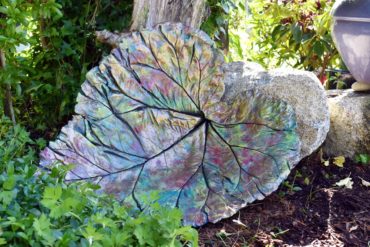 They have also had other bear sightings, and locals tell them that their land was always known for having bears. To Dorene and Marc Fretwell, the wildlife adds to the appeal of living in the forest, and their bear encounters inspired them to name their property Bearadise.
They have also had other bear sightings, and locals tell them that their land was always known for having bears. To Dorene and Marc Fretwell, the wildlife adds to the appeal of living in the forest, and their bear encounters inspired them to name their property Bearadise.
“This is paradise to us,” Fretwell says. We don’t go on vacation and do much. This is our vacation. We love it here.”




